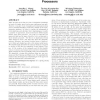Free Online Productivity Tools
i2Speak
i2Symbol
i2OCR
iTex2Img
iWeb2Print
iWeb2Shot
i2Type
iPdf2Split
iPdf2Merge
i2Bopomofo
i2Arabic
i2Style
i2Image
i2PDF
iLatex2Rtf
Sci2ools
DAC
2005
ACM
2005
ACM
Flexible ASIC: shared masking for multiple media processors
ASIC provides more than an order of magnitude advantage in terms of density, speed, and power requirement per gate. However, economic (cost of masks) and technological (deep micron manufacturability) trends favor FPGA as an implementation platform. In order to combine the advantages of both platforms and alleviate their disadvantages, recently a number of approaches, such as structured ASIC/regular fabrics, have been proposed. Our goal is to introduce an approach that has the same objective, but is orthogonal to those already proposed. The idea is to implement several ASIC designs in such a way that they share the datapath, memory structure, and several bottom layers of interconnect, while each design has only a few unique metal layers. We identified and addressed two main problems in our quest to develop a CAD flow for realization of such designs. They are: (i) the creation of the datapath, and (ii) the identification of common and unique interconnects for each design. Both problems ...
DAC 2005 | Deep Micron Manufacturability | Design Automation | Design Flow Platform | Unique Metal Layers |
| Added | 13 Nov 2009 |
| Updated | 13 Nov 2009 |
| Type | Conference |
| Year | 2005 |
| Where | DAC |
| Authors | Jennifer L. Wong, Farinaz Koushanfar, Miodrag Potkonjak |
Comments (0)

